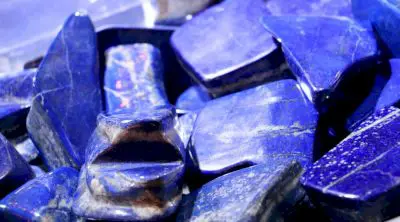Of course, in Badakhshan, which was part of Iran at that time, azure is abundant; Badakhshan headstone mine located in Kokcha mountain valley of Afghanistan (at an altitude of 2700-2600 meters) is one of the most important, famous, and best azure mines in the world that has been exploited without interruption for at least 6500 years ago

Lapis Lazuli from Afghanistan typically displays a deep, intense blue color. The presence of vivid blue hue, often described as "royal blue," is a characteristic feature of genuine Afghan Lapis Lazuli. However, it's important to note that Lapis lazuli can also contain veins or flecks of pyrite (fool's gold) or white calcite, which are natural inclusions and should not be mistaken for impurities. Authentic Afghan Lapis Lazuli often contains golden or brassy-colored pyrite inclusions. These metallic flecks, known as "fools' gold," are a distinguishing feature of Lapis Lazuli from this region. The presence of pyrite inclusions can help confirm its origin.
Azure is a metamorphic Stone with white and Gold streaks that the more gold streaks it has, the more its value. Azure is one of the semi-precious stones. This stone is made of a combination of several minerals. The most important part of this Rock is lazurite (25-40%); Lazurite contains sodium, aluminum, silica, oxygen, sulfur, and chlorine. In addition to lazurite, calcite (in the form of white streaks), sodalite, and pyrite (in the form of gold) are also among the constituents of azure; the fewer the white streaks of azure (calcite) and the more scattered the golden streaks (pyrite), the more valuable the azure will be. Also, the original azure blue the flame when it is on fire.
This stone is well polished and is considered one of the metamorphic stones. These Gemstones are sometimes confused with azurite, which is a blue (carbonated) carbonate blue rock. Azure was abundant in the Median period and its mine was known near Damavand Mountain, but so far no trace of this mineral has been seen in the Damavand region. The original locality for lapis lazuli is the Sar-e-Sang deposit in Afghanistan's remote Badakhshan district. In the Achaemenid period, azure was called "Kabutkeh". In the Sassanid period, azure was consumed a lot. The roof of Ctesiphon, as well as various sculptures, is made of azure; it is possible that they used azurite instead of azure in making these works.
Of course, in Badakhshan, which was part of Iran at that time, azure is abundant; Badakhshan headstone mine located in Kokcha mountain valley of Afghanistan (at an altitude of 2700-2600 meters) is one of the most important, famous, and best azure mines in the world that has been exploited without interruption for at least 6500 years ago.
Lapis Lazuli from Afghanistan typically has a smooth texture and a fine-grained appearance. It should feel relatively smooth to the touch when rubbed against the skin. The presence of a consistent grain pattern can be an indicator of its authenticity. Real Lapis Lazuli is relatively heavy and dense compared to imitations or other blue stones. If you have a known genuine Lapis Lazuli sample from Afghanistan, you can compare the weight and density of the stone in question to determine its authenticity.
Lapis Lazuli from Afghanistan may exhibit a weak to moderate orange fluorescence under long-wave ultraviolet (UV) light. This fluorescence is not always present, but when observed, it can be an additional indication of its authenticity. If you are uncertain about the authenticity of a Lapis Lazuli stone, seeking the opinion of a gemologist or a reputable jeweler with expertise in Gemstone identification can provide a more definitive assessment. These professionals have the knowledge and tools to examine the stone's characteristics and can help determine its authenticity.



